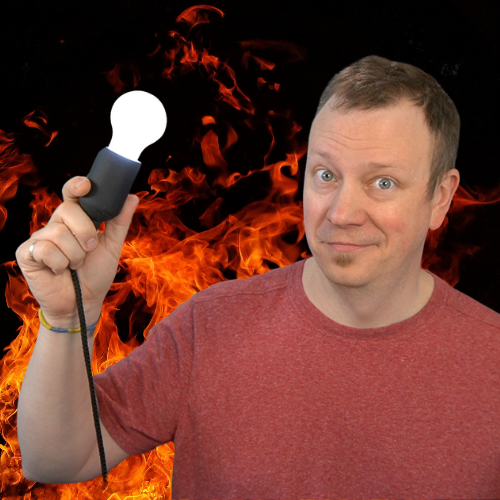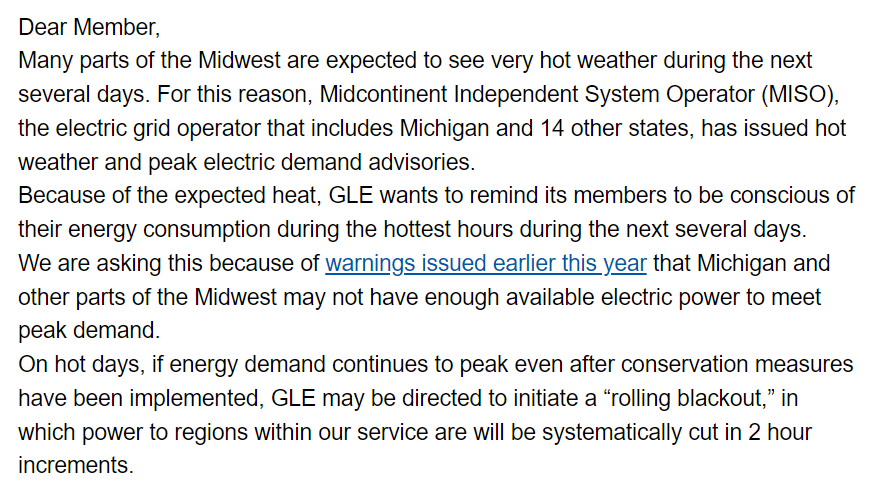
Hello Shaun,
A few months back, I got an email from GLE, which announced your new position as CEO (congrats!), along with other updates about service, fiber internet rollout, etc. One of the things I noticed in the email was that Great Lakes Energy doesn’t actually produce electricity, but buys it from a local supplier. I’m sure it’s more complex than that, but nevertheless, it got me thinking.
A couple years ago, Great Lakes Energy started a truly remarkable endeavor to provide fiber-to-the-home for all GLE members. And Truestream was born. It was, and continues to be a huge project, which I’m sure cost many millions of dollars to roll out. And as a business-class fiber customer at my farm in Brutus, I can tell you, the efforts were successful. I’m assuming there were grants and other financial resources available to you in order to help fund the connection of so many folks who otherwise had no decent options for broadband Internet service. I wonder if the same might be true for electricity… A couple days ago I got this email:

And it got me thinking. Again. What if Great Lakes Energy worked with its members, and facilitated the installation of solar and/or wind generation at the individual homes? Many of us are in rural locations, and have the space to install systems that would not only offset carbon emissions, but with grid-tying, you could buy some of the electricity you provide from your own people.
I’m not saying this without understanding many complexities exist. While solar installations would certainly help with the issue presented in the email, solar power is timed very poorly for energy needs in the winter. This is exacerbated by our eventual need to move away from burning fossil fuels to heat our homes. If we all use electric heat pumps (which, we totally should, and almost certainly will eventually), the demand for electricity will increase at night when the sun is not helping produce any power at all.
Good Point, We Should Forget the Whole Thing…
But see that’s where Great Lakes Energy could really help blaze a trail. Who better to solve the issues of energy production, distribution, storage, and independence than an electrical CO/OP who has already proven their ability to think big, and actually follow through? There will always be people like me, who have an off-grid inverter setup, with a battery bank in order to make it through potential downtimes. And less nerdy versions of me who have a standby generator in case things go sideways. But those solutions are very self-focused, and if we want to be leaders, we need to work together as the CO/OP we are. There are so many things individuals like myself can’t do alone. But a huge part of those challenges are just another Tuesday for you. Things like:
- Testing, approving, and possibly bulk purchasing hardware for grid tied inverters, solar panels, and mounting hardware that will work well, work safely, and provide people with the appropriate hardware for their needs and/or desires.
- Working with local government entities to provide clear, simple guidelines, and when local governments are unwilling to cooperate, shine light on the issue so that progress doesn’t die in a pile of paperwork.
- Work with installers, either hiring, contracting, or at the very least facilitating reputable professionals connecting with members.
- Work with folks like myself, who are passionate about such things, to educate and even help people find the line between DIY and professional installations. What can we do on our own? What should we? What shouldn’t we?
Heh, Yeah, We Already Do That
Well… about that. Yes, you have multiple programs. Three that I’m aware of, kinda. Two of them seem like the same thing worded differently. But they’re not nearly the same level of active participation as the fiber Internet initiative. Let’s talk about them, purposefully from my viewpoint, because I suspect I’m more aware of these things than most folks, and much less aware than you.
Community Solar. This appears to be a partnership with a 3rd party organization, Spartan Solar. You sort of “adopt a panel”, which is installed and maintained in a solar farm by the Spartan Solar folks. You pay for a panel, and get credited by the energy it produces. I’m certain those credits are based on averages and percentages, and are reduced by maintenance cost and financial solvency, etc, etc. On paper, this is very likely the absolute best way to implement solar in the most efficient way possible.
The problem is, it’s just a line item on a piece of paper. And apart from an abstract good feeling, there aren’t any real benefits to the end user. If your power goes out, your adopted solar panel doesn’t know, doesn’t care, and will not keep your cellphone charged so you can watch netflix during the ice storm. I suspect the interest in Community Solar isn’t zero, but also isn’t earth shattering. It’s just moving numbers on a monthly bill. If we’re going to change the world, it needs to feel real.
When you produce power on your roof, and you can see graphs of output and usage, things change. If you want to see someone get radical about energy savings, show them the data. Not abstract kilowatt hours of monthly usage, but daily watts produced and stored vs watts used. The reason people don’t take climate change seriously is they don’t experience it first hand, at least not in a way that feels real and addressable. Am I suggesting we gamify our electrical usage? YES! Members connected reliably to the Internet with fiber only makes that more possible. If people realize it takes a dozen huge solar panels in full sunlight to run their air conditioning, it becomes a tangible reason to add insulation and get better windows.
Net-Metering and Buy-All/Sell-All. From what I can tell by reading the PDF files (which were clearly written by lawyers), this is the ability for a limited number of members to pay extra for a smart meter, and then sell back excess energy they produce. This is great, truly. That said, I have no idea if the 10MW limit specified in the document has been reached, or if the program is still available. I also don’t have any idea how much extra members need to pay for smart meters to facilitate the process. And most importantly, the “how-to” bit is not only confusing, but intimidating and pretty much unattainable without lots of professional investment.
Such things are complicated, and intimidating. I get it. When you add governmental regulations, both local and regional, it’s a non-starter for the vast majority of folks. Even myself. But like I mentioned above, these regulations and interoperability with governments are what you do every day. What if there were a group of local installers, electricians, buying cooperatives (ahem, GLE), and people who know the intricacies of rolling out real community-based initiatives? What if you could show graphs on your website of the percentage of power purchased from members vs from a 3rd party? What if a farmer with a south-facing clearing could install enough solar panels to make a bit of income each month while supplying all their own power/heating/cooling needs?
OK, Sure, But That’s Not a Plan.
Right. My hope is that we can make it easier for people to install things like solar. This will require several things:
- Education. This is the part I can actually help accomplish. Remember when I was one of the first folks to get fiber Internet installed, and y’all took pictures, etc? (It’s ok if you don’t remember, you weren’t there personally) Let’s expand that idea. Let’s highlight various solar/wind/battery/inverter installations members have in place, or plan to put in place. I’m an educator who is comfortable making video. Let’s show people what’s possible!
- Easy Access. Most people I know with solar installations got the hardware and labor as part of a contract, which makes their payment and saved electrical usage just about a wash. That requires capital, and I would bet there are governmental grants to help facilitate such things. I’m really nerdy, and really into this stuff. Yet I have no idea how to get something like a solar panel system installed. That’s partially on me, but it points to a bigger problem: No one knows what is possible, much less how to accomplish it.
- Incentive. It needs to be sexy. There is so much more we need to do than just putting solar panels on houses. But getting people to be active participants in the energy conversation seems like a really good first step. This is mostly marketing, but wouldn’t it be great to have an actionable alternative to the rolling blackouts mentioned in the email above? “Use less power” is an admirable goal, but long term it’s not sustainable. The future will be powered by electricity, and being proactive about scaling our power needs before garages are filled with electric vehicles seems like an even more admirable goal!
I truly can’t think of any other entity more poised to lead the way toward a cleaner, more self-sufficient nation. Once we are more actively involved with producing electricity, and owning the process — things like transitioning away from propane furnaces become a much easier conversation. But the first step is to get people interested in having the conversation. And making everyone an active part of the process seems like a good way to start.
So drop me a line, Shaun. Let’s change the world, starting in one of the most unlikely places — our own backyards.